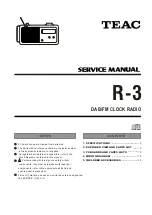NXP Semiconductors
UM10276_1
TED-Kit 2 User Manual
All information provided in this document is subject to legal disclaimers.
© NXP B.V. 2010. All rights reserved.
User manual
Rev. 1.29 — 20 August 2010
46 of 79
For a user Homer running version 3.1.0 of the GUI, this might resolve on a typical Win-
dows installation to:
C:\Documents and Settings\Homer\Application Data\NXP Semiconductors\TED-Kit 2\3.1.0
6.6.1 ABIC1 configuration window
The configuration and monitoring window allows to set the ABIC1 XBoard configuration
as wells as to monitor several status information. To open the window, select the desired
XBoard from the hardware view tree and select from the menu
B
B
o
o
a
a
r
r
d
d
C
C
o
o
n
n
f
f
i
i
g
g
u
u
r
r
e
e
&
&
M
M
o
o
n
n
i
i
-
-
t
t
o
o
r
r
X
X
B
B
o
o
a
a
r
r
d
d
…
…
or double-click the tree node of the desired XBoard or click the
C
C
o
o
n
n
f
f
i
i
g
g
u
u
r
r
e
e
…
…
button in the applet window.
The window consists of three parts. The upper part shows some status information, the
middle part allows to set default values depending on a transponder family and the lower
part gives direct access to all the ABIC1 specific settings and status information.
Default settings
The default settings for an ABIC1 XBoard depend on the transponder family which will be
used with this XBoard. Thus, setting default values involves two steps:
1. Selecting the desired transponder family.
2. Clicking the
D
D
e
e
f
f
a
a
u
u
l
l
t
t
button.
If this window is opened from the applet window via
C
C
o
o
n
n
f
f
i
i
g
g
u
u
r
r
e
e
…
…
, the already chosen
transponder family is preset for the default button.
6.6.2 LoPSTer configuration window
The configuration and monitoring window allows to set the LoPSTer XBoard configura-
tion as wells as to monitor several status information. To open the window, select the
desired XBoard from the hardware view tree and select from the menu
B
B
o
o
a
a
r
r
d
d
C
C
o
o
n
n
f
f
i
i
g
g
u
u
r
r
e
e
&
&
M
M
o
o
n
n
i
i
t
t
o
o
r
r
X
X
B
B
o
o
a
a
r
r
d
d
…
…
or double-click the tree node of the desired XBoard or click the
C
C
o
o
n
n
-
-
f
f
i
i
g
g
u
u
r
r
e
e
…
…
button in the applet window.
The “configure and monitoring” window consists of three parts. The upper part shows
some status information, the middle part allows to load and save configurations.
The lower part gives direct access to all the LoPSTer specific settings and status infor-
mation. When opening the LoPSTer configuration window the current settings from the
chip will be read out first. Many settings are possible but be careful if you do not have
much experience with this settings. Thus it is recommended to use the Load/Save fea-
tures.
6.7 Immobilizer applet window
To open this window, the appropriate tree node of the desired transponder family below
the Immobilizer tree node of the applet view has to be double-clicked.
The window itself consists of three parts. The upper part defines the infrastructure of the
applet by means of what base station and what transponder family is being used.
The middle part controls the immobilizer application itself and provides status information
of the authentication between base station and transponder.
The lower part defines all the settings for the communication and authentication between
base station and transponder.


















